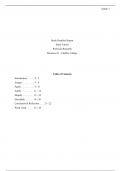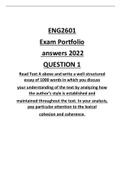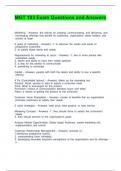Chapter 1 What are organizations?
All companies and other organizations undergo changes that can be illuminated and informed by theories of
organization and its design. Organizing involves continuous challenges in the face of uncertainty and change.
Organizations are not static. There is a continuous process of adaptation in response to changes beyond the
organization. Coping with rapid change is the most common problem facing managers and organizations. Some specific
challenges are :
1. Globalization: Markets, technologies and organizations are becoming increasingly interconnected. It is more
feasible to locate different parts of an organization wherever it makes the most business sense. A related
trend is to contract out some functions to organizations in other countries or to partner with foreign
organizations to gain global advantage.
2. Ethics and social responsibility: Issues of ethics and sociale responsibility (relating to concerns about ecological
sustainability, and not just corporate survival) are becoming increasingly important and corporations in
particular are being expected to take a lead on addressing these issues.
3. Responsiveness: Respond quickly and decisively to environmental changes, organizational crises and shifting
customer expectations. Today, globalization and advancing technology have accelerated the pace at which
organizations must adapt their internal structures and systems in order to keep rolling out new products and
services that are sufficiently competitive. The financial basis of today’s economy is information, not machines
and factories. Knowledge involved in designing and coordinating the manufacture of products and the delivery
of services becomes increasingly important. Employees provide best chance of organizational prosperity.
4. The digital workplace: More business takes place by digital processes. Disintermediation is eliminating the
middleman often by consuming the unpaid time of the customer who, for example, experiences the
frustration of waiting for, and dealing with, responses from call centres. It affects every industry.
5. Diversity: People from diverse ethnic and cultural backgrounds offer varying styles of interacting and working.
Managing diversity may be one of the most rewarding challenges for organizations competing on global basis.
• Organizations are social entities that are goal-directed, are designed as deliberately structured and
coordinated activity systems and are linked to the external environment.
• Key element of an organization is not a building or a set of policies and procedures. Organizations are made up
of people and their relationships with one another.
An important distinction between organizations is:
• For-profit businesses: Activities of managers in for-profit organizations are directed primarily at producing
goods and services in a way that retains the confidence of shareholders. Managers focus on developing and
positioning the organization’s products and services in ways that are intended to increase sales revenues.
• Nonprofit organizations: Difficulty of securing funding or raising capital or competing with profit-making
businesses. Financial resources typically come from government grants, private foundation grants and
donations. Are responsive to demands that are inadequately met by markets. Services are often provided to
non-paying clients.
• Social enterprise strives to combine commercial activity generating revenu with the pursuit of social goals.
Importance of organizations:
• Bringing together resources to achieve desired goals and outcomes
• Producing goods and services
• Facilitating innovation
• Harnessing modern manufacturing, service and information technologies
• Adapting to and influencing a changing environment
• Creating value
• Accommodating ongoing challenges of diversity, ethics and the motivation and coordination of employees
,Summary and interpretation:
• Organizations have been conceived as systems that either adapt to, or exert control over, the environment as
a means of pursuing the goals of their dominant stakeholders.
• The primary focus of analysis for organization theory is employees’ activities as organizational members.
• A focus of this book is how organization structures are influenced by the wider environment, and how key
decision makers attempt to manage their environment by designing effective structures.
• Many types of organizations exist.
, Chapter 2 Perspectives on organizations
Images of organization (Gareth Morgan):
• All theories of organization and management are based on implicit images and associated languages.
• Understandings and theories of organization and management are based on some metaphor.
• Core idea: we act on the basis of how we conceive, metaphorically, of what organizations are.
• Important to be familiar with and open to numerous perspectives.
• Addressing organizations and their problems from multiple metaphorical perspectives is more consistent with
dealing with complexity rather than trivializing or simplifying it.
• Metaphores identified and explored in Images of Organization:
- Organizations as Machines
- Organizations as Organism
- Organizations as Brain
- Organizations as Culture
- Organizations as Political
- Organizations as Psychic Prisons
- Organizations as Flux and Transformation
- Organizations as Instruments of Domination
• Closed system: focuses exclusively upon the organization. Minimal consideration to its dependencies upon, or
capacities to influence, elements that lie beyond it. Organizations are conceived as self-contained (op zichzelf
staand), effectively sealed off from the outside world.
• Open system: Pays attention to the (open) boundary between the organization and its context. Organizations
are conceived as consumers of resources (inputs) and exporters of resources (outputs). The relevance of open
systems has been underscored with regard to changes relating to explosion of the internet and e-business,
growing diversity of the workforce and the opening up of low wage labour economies and the participation of
even newer (and lower-cost) entrants in the global economy.
• In systems thinking, each system is understood to comprise several subsystems. These are identified in relation
to the specific functions they are conveiced to perform for organizational survival:
- The production subsystem produces the product and service outputs.
- Boundary subsystems are responsible for enabling exchanges with the external environment.
- Maintaining the smooth operation and upkeep of the organization’s physical and human elements is
to be performed by the maintenance subsystem.
- The adaptive subsystems are responsible for organizational change and adaptation.
- Management is a distinct subsystem, responsible for coordinating and directing the other subsystems.
, • Henry Mintzberg suggests that every organization has five parts:
1. Technical core: Performs the production subsystem function and produces the product and service
outputs. It’s where the primary transformation from input to output takes place.
2. Top management: Provides direction, strategy, goals and policies for the entire organization.
3. Middle management: Responsible for implementation and coordination at the departmental level.
4. Technical support: Scan the environment for problems, opportunities and technological developments.
Responsible for creating innovations in the technical core, helping the organization change and adapt.
Departments such as technology, research and development (R&D) and marketing research.
5. Administrative support: Responsible for the smooth operation and upkeep of the organization. Includes
human resource activities (recruiting/hiring) as well as maintenance activities such as cleaning of
buildings. Functions include the human resource department and maintenance staff.
These parts may vary in size and importance depending on an organization’s particular environment, its
technology and other factorts.
• Organizational dimensions can be categorized in two types:
1. Structural: Provide labels to distinguish some key, internal characteristics of an organization. They provide
a basis for comparing the composition of organizations.
- Formalization: Reliance upon written documentation in the organization (like rules).
- Specialization: The degree to which organizational tasks are subdivided into separate jobs.
- Hierarchy of authority: Describes who reports to whom and the span of control for each manager.
When spans of control are narrow, specialization is high and the hierarchy tends to be tall.
- Centralization: Refers to the hierarchical level that has authority to make a decision. When decision-
making is kept at top level, the organization is centralized. When decisions are delegated to lower
organizational levels, it is decentralized.
- Professionalism: Term used to describe the level of formal education and training of employees.
- Personnel ratios: Refer to the deployment of people to various functions and departments. A
personnel ratio is measured by dividing the number of employees in a classification by the total
number of organizational employees.
2. Contextual: Characterize both the organization as a whole and the broader organizational setting.
- Size: Can be measured for the organization as a whole or for specific components.
- Organizational technology: Refers to the tools, techniques and actions used to transform inputs into
outputs. It concerns how the organization produces products and services it provides for customers.
- Environment: Includes all elements outside the boundary of the organization. Key elements include
the industry, government, customers, suppliers and the financial community.
- Goals and strategy: Define the purpose and competitive techniques that set it apart from other
organizations. Goals are often written down as an enduring statement of company intent. A strategy
is the plan of action that describes resource allocation and activities for dealing with the environment
and for reaching the organization’s goals.
- Culture: Underlying set of values, beliefs, understandings and norms shared by employees.
All companies and other organizations undergo changes that can be illuminated and informed by theories of
organization and its design. Organizing involves continuous challenges in the face of uncertainty and change.
Organizations are not static. There is a continuous process of adaptation in response to changes beyond the
organization. Coping with rapid change is the most common problem facing managers and organizations. Some specific
challenges are :
1. Globalization: Markets, technologies and organizations are becoming increasingly interconnected. It is more
feasible to locate different parts of an organization wherever it makes the most business sense. A related
trend is to contract out some functions to organizations in other countries or to partner with foreign
organizations to gain global advantage.
2. Ethics and social responsibility: Issues of ethics and sociale responsibility (relating to concerns about ecological
sustainability, and not just corporate survival) are becoming increasingly important and corporations in
particular are being expected to take a lead on addressing these issues.
3. Responsiveness: Respond quickly and decisively to environmental changes, organizational crises and shifting
customer expectations. Today, globalization and advancing technology have accelerated the pace at which
organizations must adapt their internal structures and systems in order to keep rolling out new products and
services that are sufficiently competitive. The financial basis of today’s economy is information, not machines
and factories. Knowledge involved in designing and coordinating the manufacture of products and the delivery
of services becomes increasingly important. Employees provide best chance of organizational prosperity.
4. The digital workplace: More business takes place by digital processes. Disintermediation is eliminating the
middleman often by consuming the unpaid time of the customer who, for example, experiences the
frustration of waiting for, and dealing with, responses from call centres. It affects every industry.
5. Diversity: People from diverse ethnic and cultural backgrounds offer varying styles of interacting and working.
Managing diversity may be one of the most rewarding challenges for organizations competing on global basis.
• Organizations are social entities that are goal-directed, are designed as deliberately structured and
coordinated activity systems and are linked to the external environment.
• Key element of an organization is not a building or a set of policies and procedures. Organizations are made up
of people and their relationships with one another.
An important distinction between organizations is:
• For-profit businesses: Activities of managers in for-profit organizations are directed primarily at producing
goods and services in a way that retains the confidence of shareholders. Managers focus on developing and
positioning the organization’s products and services in ways that are intended to increase sales revenues.
• Nonprofit organizations: Difficulty of securing funding or raising capital or competing with profit-making
businesses. Financial resources typically come from government grants, private foundation grants and
donations. Are responsive to demands that are inadequately met by markets. Services are often provided to
non-paying clients.
• Social enterprise strives to combine commercial activity generating revenu with the pursuit of social goals.
Importance of organizations:
• Bringing together resources to achieve desired goals and outcomes
• Producing goods and services
• Facilitating innovation
• Harnessing modern manufacturing, service and information technologies
• Adapting to and influencing a changing environment
• Creating value
• Accommodating ongoing challenges of diversity, ethics and the motivation and coordination of employees
,Summary and interpretation:
• Organizations have been conceived as systems that either adapt to, or exert control over, the environment as
a means of pursuing the goals of their dominant stakeholders.
• The primary focus of analysis for organization theory is employees’ activities as organizational members.
• A focus of this book is how organization structures are influenced by the wider environment, and how key
decision makers attempt to manage their environment by designing effective structures.
• Many types of organizations exist.
, Chapter 2 Perspectives on organizations
Images of organization (Gareth Morgan):
• All theories of organization and management are based on implicit images and associated languages.
• Understandings and theories of organization and management are based on some metaphor.
• Core idea: we act on the basis of how we conceive, metaphorically, of what organizations are.
• Important to be familiar with and open to numerous perspectives.
• Addressing organizations and their problems from multiple metaphorical perspectives is more consistent with
dealing with complexity rather than trivializing or simplifying it.
• Metaphores identified and explored in Images of Organization:
- Organizations as Machines
- Organizations as Organism
- Organizations as Brain
- Organizations as Culture
- Organizations as Political
- Organizations as Psychic Prisons
- Organizations as Flux and Transformation
- Organizations as Instruments of Domination
• Closed system: focuses exclusively upon the organization. Minimal consideration to its dependencies upon, or
capacities to influence, elements that lie beyond it. Organizations are conceived as self-contained (op zichzelf
staand), effectively sealed off from the outside world.
• Open system: Pays attention to the (open) boundary between the organization and its context. Organizations
are conceived as consumers of resources (inputs) and exporters of resources (outputs). The relevance of open
systems has been underscored with regard to changes relating to explosion of the internet and e-business,
growing diversity of the workforce and the opening up of low wage labour economies and the participation of
even newer (and lower-cost) entrants in the global economy.
• In systems thinking, each system is understood to comprise several subsystems. These are identified in relation
to the specific functions they are conveiced to perform for organizational survival:
- The production subsystem produces the product and service outputs.
- Boundary subsystems are responsible for enabling exchanges with the external environment.
- Maintaining the smooth operation and upkeep of the organization’s physical and human elements is
to be performed by the maintenance subsystem.
- The adaptive subsystems are responsible for organizational change and adaptation.
- Management is a distinct subsystem, responsible for coordinating and directing the other subsystems.
, • Henry Mintzberg suggests that every organization has five parts:
1. Technical core: Performs the production subsystem function and produces the product and service
outputs. It’s where the primary transformation from input to output takes place.
2. Top management: Provides direction, strategy, goals and policies for the entire organization.
3. Middle management: Responsible for implementation and coordination at the departmental level.
4. Technical support: Scan the environment for problems, opportunities and technological developments.
Responsible for creating innovations in the technical core, helping the organization change and adapt.
Departments such as technology, research and development (R&D) and marketing research.
5. Administrative support: Responsible for the smooth operation and upkeep of the organization. Includes
human resource activities (recruiting/hiring) as well as maintenance activities such as cleaning of
buildings. Functions include the human resource department and maintenance staff.
These parts may vary in size and importance depending on an organization’s particular environment, its
technology and other factorts.
• Organizational dimensions can be categorized in two types:
1. Structural: Provide labels to distinguish some key, internal characteristics of an organization. They provide
a basis for comparing the composition of organizations.
- Formalization: Reliance upon written documentation in the organization (like rules).
- Specialization: The degree to which organizational tasks are subdivided into separate jobs.
- Hierarchy of authority: Describes who reports to whom and the span of control for each manager.
When spans of control are narrow, specialization is high and the hierarchy tends to be tall.
- Centralization: Refers to the hierarchical level that has authority to make a decision. When decision-
making is kept at top level, the organization is centralized. When decisions are delegated to lower
organizational levels, it is decentralized.
- Professionalism: Term used to describe the level of formal education and training of employees.
- Personnel ratios: Refer to the deployment of people to various functions and departments. A
personnel ratio is measured by dividing the number of employees in a classification by the total
number of organizational employees.
2. Contextual: Characterize both the organization as a whole and the broader organizational setting.
- Size: Can be measured for the organization as a whole or for specific components.
- Organizational technology: Refers to the tools, techniques and actions used to transform inputs into
outputs. It concerns how the organization produces products and services it provides for customers.
- Environment: Includes all elements outside the boundary of the organization. Key elements include
the industry, government, customers, suppliers and the financial community.
- Goals and strategy: Define the purpose and competitive techniques that set it apart from other
organizations. Goals are often written down as an enduring statement of company intent. A strategy
is the plan of action that describes resource allocation and activities for dealing with the environment
and for reaching the organization’s goals.
- Culture: Underlying set of values, beliefs, understandings and norms shared by employees.












